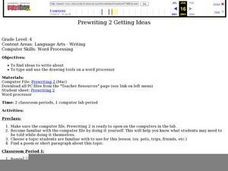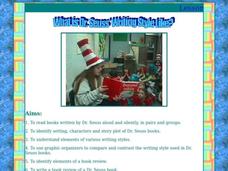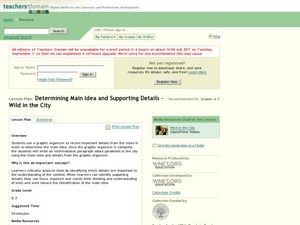Curated OER
How Do Scientists Classify Organisms?
In this classification worksheet, students write in examples of the 6 kingdoms: archaebacteria, eubacteria, protists, fungi, plants, and animals. This worksheet is a graphic organizer.
Curated OER
Prewriting 2 Getting Ideas
Fourth graders read a poem or short paragraph and have students picture it in their minds. They relate the topic to something in their experience and illustrate, 4th graders generate questions with a graphic organizer, use Prewriting2...
Curated OER
Reader Response
Fifth graders reflect upon different concepts of Language Arts while reading literature. In the novel Tuck Everlasting, by Natalie Babbitt, the characters discover a spring of eternal youth. After reading the first several chapters of...
Curated OER
What is it...A Frog or a Toad?
Students write a story. In this frogs and toads comparison instructional activity, students read facts comparing frogs and toads, use a t-chart to record factual information and complete a Venn Diagram. Students complete a four square...
Curated OER
Adventurous Magic
Students investigate storytelling by creating their own dialogue. In this writing development lesson, students read the story Jeremy Thatch, Dragon Hatcher in class and discuss their own magical object they wish to write a story about....
Curated OER
Books on Trial
Sixth graders persuade classmates that their favorite book is the best book ever written. In this persuasive writing instructional activity, 6th graders create a written argument as to why their favorite book is the best. Students...
Curated OER
A River, Dead or Alive: Native Americans and European Colonists' Treatment of a River
Students write an expository paragraph about the uses of the Nashua River for the Native Americans and the European Colonists. In this river uses lesson plan, students determine the causes and effects of both parties using the river.
Curated OER
Product Persuasion
Young scholars examine various products and analyze the marketing strategies used to entice consumers. They bring in a product they like to use, and using persuasive writing, they write their own advertisements for their products.
Curated OER
Picture the Process
Students read Chasing Vermeer and relate the book to the author . In this writing process lesson, students view Blue's Photo Album and see how the author writes and revises her work. Students discuss the process that all good...
Curated OER
Dr. Seuss
Young scholars read books by the same author and compare what they find. In this Dr. Seuss lesson, students learn about Dr. Seuss' writing style, listen for the rhyme scheme in his stories, and create a KWL chart on Dr....
Curated OER
Thomas Jefferson's Library: Making the Case for a National Library
Learners examine the need for a national library. In this Library of Congress instructional activity, students analyze primary sources to investigate the persuasive techniques that Thomas Jefferson used in a letter meant...
Curated OER
It's Your Birthday! Expository Writing Unit 2
Young scholars create an expository essay. In this writing lesson Students are assigned a country and must conduct research surrounding a historic event that occurred in that country at the time of their birth.
Curated OER
"How To Build A Snowman" Expository Writing
Fourth graders write a "how to..." or an expository essay on building a snowman. They practice giving directions by explaining how to draw a person using shapes without mentioning that it's a person being drawn. They revise through the...
Curated OER
Organizing Writing/Composing a First Draft
Seventh graders access an organizer from an earlier lesson and transition sentences to begin a new essay. In this organization and composing lesson, 7th graders work in small groups to create a draft of an article about...
Curated OER
FCAT Writes! Frenzy
Fourth graders experience a dress rehearsal of timed demand writing. This lesson allows students to prepare for a timed writing test in which they don't know the prompt. This lesson includes writing prompts and rubrics imbedded in the plan.
Curated OER
Organizer --triple Venn Diagram
In this graphic organizer worksheet students use this triple Venn diagram to compare 3 things. Students can organize facts and compare and contrast.
Curated OER
Concrete Detail and Commentary
In this writing skills worksheet, students practice writing with facts or quotes from a text by following the graphic organizer format. Students write the concrete detail and then list two commentaries for their facts or quotes.
Curated OER
Determining Main Idea and Supporting Details-Wild in the City
Students discuss the main idea of a story. For this writing process lesson, students use a video about parakeets as a tool to find the main idea of a story. After viewing the video, they engage in a discussion about...
Curated OER
Travel Brochure Prewriting Worksheet
In this prewriting skills worksheet, learners complete the provided graphic organizer as they research the Greek islands in order to create informative brochures about the area.
Scholastic
Ready to Research Owls
Researching facts about owls can be a hoot for your class. Let them wisely collaborate on this writing project. The resource is the second part of three parts. It is best to use all three lessons in order.
EngageNY
Drafting Body Paragraphs
That's just the style. Learners begin with a mini-lesson about formal writing style. They then use what they learned about formal writing to begin the body paragraphs for their End of Unit 1 Assessment Prompt: Adversity in the Middle...
Consortium for Ocean Science Exploration and Engagement (COSEE)
Understanding the Food Web
Building on prior knowledge of the pervious lesson in the series, pupils explain the previous lesson to each other. Then they write a simple guide for a young child to read on the same topic.
ReadWriteThink
Biography Project: Research and Class Presentation
I Have A Dream ... that after the lesson, all individuals master the reading, writing, researching, listening, and speaking skills the biography project helps them develop. Martin Luther King, Jr. serves as a topic example for a model...
Alabama Learning Exchange
Who, What, When, Where, Why, How?
Your youngsters are just starting to read texts and pull out important information. Use this graphic organizer with any text to help them practice identifying the who, what, when, where, why, and how of a text. Although the format of the...

























